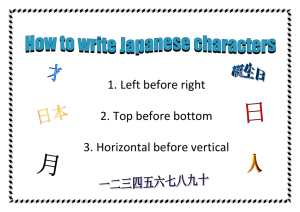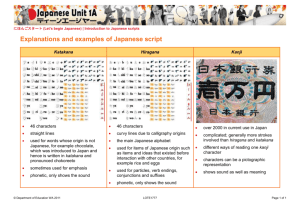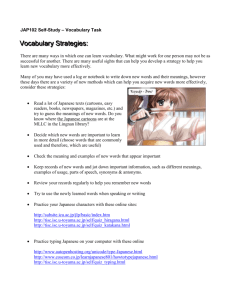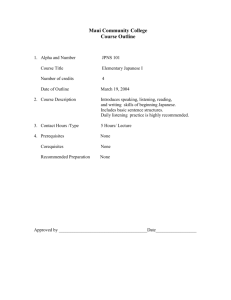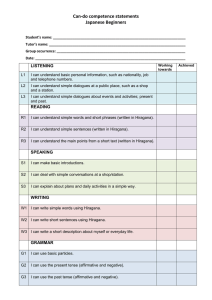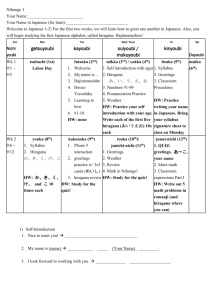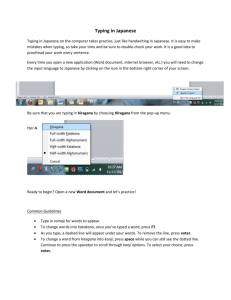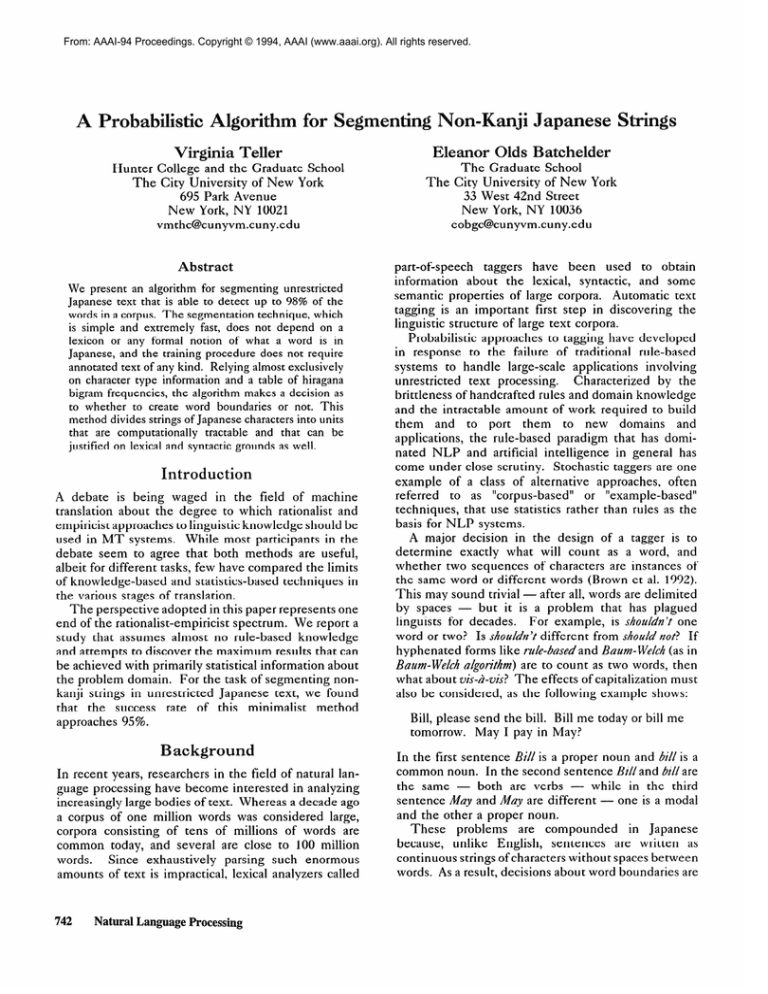
From: AAAI-94 Proceedings. Copyright © 1994, AAAI (www.aaai.org). All rights reserved.
stic Algorithm for Segmenting Non-Kanji Japanese Strings
Virginia Teller
Eleanor Olds Batchelder
Hunter College and the Graduate School
The City University
of New York
695 Park Avenue
New York, NY 10021
vmthc@cunyvm.cuny.edu
The
Abstract
We present an algorithm for segmenting
unrestricted
Japanese text that is able to detect up to 98% of the
words in a corpus. The segmentation
technique, which
is simple and extremely
fast, does not depend on a
lexicon or any formal notion of what a word is in
Japanese, and the training procedure does not require
annotated text of any kind. Relying almost exclusively
on character type information
and a table of hiragana
bigram frequencies,
the algorithm makes a decision as
to whether
to create word boundaries
or not. This
method divides strings of Japanese characters into units
that are computationally
tractable
and that can be
justified on lexical and syntactic grounds as well.
Introduction
A debate
is being
translation
about
waged
the
in the
degree
field
to which
of machine
rationalist
and
empiricist approaches to linguistic knowledge should be
used in MT systems.
While most participants
in the
debate seem to agree that both methods are useful,
albeit for different tasks, few have compared the limits
of knowledge-based
and statistics-based
techniques
in
the various stages
The perspective
of translation.
adopted in this paper represents one
end of the rationalist-empiricist
spectrum.
We report a
study
that
assumes
almost
no rule-based
knowledge
and attempts to discover the maximum results that can
be achieved with primarily statistical information about
the problem
domain.
For the task of segmenting
nonkanji
that
strings
in unrestricted
the
success
rate
of
approaches
Japanese
text,
this
minimalist
we found
method
years,
guage processing
researchers
common
words.
amounts
742
consisting
in the
have become
increasingly
large bodies
a corpus of one million
corpora
part-of-speech
taggers have been
used to obtain
information
about the lexical, syntactic,
and some
semantic properties of large corpora.
Automatic
text
tagging is an important
first step in discovering
the
linguistic structure of large text corpora.
Probabilistic
approaches to tagging have developed
in response
to the failure of traditional
rule-based
systems to handle large-scale
applications
involving
unrestricted
text processing.
Characterized
by the
brittleness of handcrafted
rules and domain knowledge
and the intractable
amount of work required to build
them
and to port them
to new domains
and
applications,
the rule-based
paradigm that has dominated NLP and artificial intelligence
in general has
come under close scrutiny.
Stochastic taggers are one
example
of a class of alternative
approaches,
often
referred
to as “corpus-based”
or “example-based”
techniques,
that
use statistics
rather
than
rules
as the
basis for NLP systems.
A major decision in the design of a tagger is to
determine
exactly what will count as a word, and
whether two sequences
of characters are instances of
the same word or different words (Brown et al. 1992).
This may sound trivial - after all, words are delimited
by spaces but it is a problem
that has plagued
linguists for decades.
For example,
is s~ozlldn’t one
word or two? Is s/zozcldn’t different from shoz&i not? If
hyphenated
forms like rzcle-basedand Baum-Welch (as in
Baum-Web-h algonkh)
are to count
as two words,
then
what about vis-h-vis? The effects of capitalization
must
also be considered,
as the following example shows:
Bill, please send the bill. Bill me today or bill me
tomorrow.
May I pay in May?
9.5%.
Background
In recent
The Graduate School
City University
of New York
33 West 42nd Street
New York, NY 10036
eobgc@cunyvm.cuny.edu
field
interested
of text.
Whereas
of natural
lan-
in analyzing
a decade
ago
words was considered
large,
of tens of millions of words are
today, and several
are close to 100 million
Since
exhaustively
parsing such enormous
of text is impractical,
lexical analyzers
called
NaturalLanguage Processing
In the first sentence Bill is a proper noun and bill is a
common noun. In the second sentence Bill and bill are
the same both are verbs while in the third
sentence May and May are different - one is a modal
and the other a proper noun.
These
problems
are compounded
in Japanese
because,
unlike
English,
sentences
are written
as
continuous strings of characters without spaces between
words. As a result, decisions about word boundaries are
all the more difficult,
and lexical analysis plays an
important
preprocessing
role in all Japanese
natural
Before text can be parsed, a lexical
language systems.
analyzer must segment the stream of input characters
comprising each sentence.
Japanese
lexical
analyzers
typically
segment
sentences
in two major steps, first dividing
each
sentence into major phrases called bzcnsetszlcomposed of
a content word and accompanying
function words, e.g.
noun+particle,
verb+endings,
and then discovering the
individual words within each phrase. Algorithms based
on the longest match principle perform the bulk of the
work (Kawada 1990). To extract a bunsetsu structure
from an input string, the system first proposes the
longest candidate that matches a dictionary entry and
then checks whether the result agrees with the rules for
If the check fails, the system
bunsetsu
composition.
backtracks, proposes another shorter word, and checks
the composition
rules again. This process is repeated
until the sentence is divided into the least number of
bunsetsu
consistent
with its structure
(Ishizaki et al.
1989).
Maruyama et al. (1988) describe a sentence analyzer
that consists of five stages, each of which exploits a
distinct kind of knowledge
that is stored in the form of
The five stages are:
a set of rules or a table.
segmentation
by (1) character
type, (2) character
sequence,
and (3) a longest matching algorithm; (4) a
bottom-up
parallel algorithm if stage 3 fails; and (5)
compound-word
composition.
The first three lines in
the transliterated
example below illustrate what the
procedure must accomplish:
input:
bunsetsu:
words:
meaning:
translation:
sisutemugabunobunkaisuru.
sisutemuga/buno/bunkaisuru.
sisutemu-ga/bun-o/bunkai-suru.
system-subj/sentence-obj/analyze-nonpast
A/The system analyzes a/the sentence.
Two recent projects at BBN have used rule-based
lexical analyzers to construct
probabilistic
models of
Japanese segmentation
and part-of-speech
assignment.
Matsukawa,
Miller, & Weischedel
(1993) based their
work on JUMAN,
developed
at Kyoto University,
which has a 40,000 word lexicon and tags with a success
rate of about 93%. They used hand-corrected
output
from JUMAN to train an example-based
algorithm to
correct both segmentation
errors and part of speech
errors in JUMAN’s output.
POST, a stochastic tagger,
then selects among ambiguous alternative segmentation
and part-of-speech
assignments
and predicts the part of
speech of unknown words. Papageorgiou
(1994) trained
a bigram hidden Markov model to segment Japanese
text using the output
of MAJESTY,
a rule-based
morphological
preprocessor
(Kitani & Mitamura 1993)
that is reported to segment and tag Japanese text with
better than 98% accuracy. Papageorgiou’s
method uses
neither a lexicon of Japanese words nor explicit rules,
basing its decisions instead solely on whether a twocharacter sequence is deemed more likely to continue
a word or contain a word boundary.
This approach was
able to segment 90% of the words in test sentences
correctly, compared
to 91.7% for the JUMAN-based
method.
Characteristics
of Japanese Text
Japanese text is composed
of four different
types of
characters:
kanji characters
borrowed
more than a
millennium
ago from Chinese;
two kana syllabaries,
hiragana and katakana; and romaji, consisting of Roman
alphabetic
and Arabic numeral
characters.
The
syllabaries
contain
equivalent
sets of around
80
characters each. Hiragana is used for Japanese words
and inflections,
while katakana
is used for words
borrowed from foreign languages and for other special
purposes.
Lunde (1993:4) describes the distribution
of
character types as follows:
Given an average sampling of Japanese writing,
one normally finds 30 percent kanji, 60 percent
hiragana, and 10 percent katakana.
Actual percentages depend on the nature of the text. For
example, you may find a higher percentage
of
kanji in technical literature, and a higher percentage of katakana in the literature of fields such as
computer
science, which make extensive
use of
loan words written in katakana.
The variable proportions of character types can easily
be seen in a comparison
of three different samples of
Japanese
text.
The first corpus consists of a set of
short newspaper
articles on business
ventures
from
The second corpus contains
a series of
Yomiu?i.
editorial columns from Asahi Shinbun (tenseijingo shasetsu,
19851991).
Information
on a third corpus was drawn
from the description
provided by Yokoyama (1989) of
an online dictionary, Shin-Meikai Kokugo Jiten. Table 1
gives the size of each corpus in thousands of characters
and shows the percentage of text written in each of the
four character types. Punctuation
and special symbols
have been excluded from the counts.
bus.
size (K chars)
% hiragana
% kanji
% katakana
% num/rom
42
30.2
47.5
19.3
2.9
ed.
diet.
275
58.0
34.6
4.8
2.6
2,508
52.4
37.9
6.8
2.9
Table 1
Of particular note is the fact that the business corpus
contains roughly half the amount of hiragana of the
other two samples,
both of which come close to
Corpus-Based
743
Lunde’s
norm, and three to four times as much
katakana.
Table 2 lists the ten most frequent hiragana
in the three corpora expressed as a percentage
of total
hiragana.
editorial
business
no
to
ru
wo
ni
ha
de
si
ta
ga
13.1
6.7
6.6
6.5
5.6
5.5
5.5
5.3
4.4
3.6
no
i
to
ru
8.3
6.3
4.5
4.5
i-i
ha
ga
wo
na
4.5
4.4
4.1
4.0
3.7
3.5
dictionatv
no
ru
i
ni
to
wo
na
si
su
ta
7.8
6.3
4.8
4.4
4.1
3.9
3.5
3.4
3.2
3.1
Table 2
Again, the business
corpus exhibits characteristics
that differ significantly from the editorial and dictionary
samples. Although no is the most frequent hiragana in
all three texts, it occurs almost twice as often in the
business sample. Since one function of the particle no
is to combine
nouns into noun phrases, this result
suggests there is a large amount of such compounding
In contrast, hiragana i and na,
in business
writing.
which appear in adjective inflections,
are not found in
the business top ten list, even though both are among
the top ten in the other two corpora, and i is in the top
three.
Defining a Word
Exactly what constitutes
a word in Japanese
for
segmentation
purposes is a controversial
issue. Without
spaces that delimit lexical units, the decision may be
left largely to the designer of a particular segmentation
BENKYOUsiteimasita
‘was
The bunsetsu
method.
written
with two initial kanji characters
studying’,
(shown in upper case below) and seven hiragana, can
be considered
a single lexical unit or can be divided
into as many as six elements:
BEN+KYOU
containing
- si - te - i - ma+si - ta
the sequence:
‘study’ - ‘do’ - particle - progressive
- polite - past
or into some other intermediate
grouping.
Because of
this flexibility,
the word boundaries
produced
by a
particular segmentation
method may vary from fairly
large
lexical
units
to small
ones
closer
to a
morphological
level of analysis, and several positions
along this spectrum
can easily be defended.
The
consistency with which a segmenter makes its decisions
is more important
than the position taken on word
can be
boundaries.
Systematic
errors in output
accounted
for later in processing no matter what size
744
Natural Language Processing
units
are produced.
The Segmentation
Algorithm
The strategy underlying
the design of the present
segmentation
algorithm was to discover the maximum
results that could be achieved
with a minimum
of
computational
(and human) effort.
To this end, the
algorithm incorporates a simple statistical technique for
segmenting
hiragana strings into words, a measure that
is loosely based on the notion of mutual information
(Brill et al. 1990, Magerman & Marcus 1990).
During the first stage of processing, a program scans
an input file of Japanese
text and identifies
each
character as one of five types:
:h]
:K]
:k]
[P]
hiragana
kanji
katakana
punctuation
and symbols
romaji (Roman letters and Arabic numbers)
For each hiragana character the algorithm computes a
bigram frequency count based on the type of character
that immediately
precedes and follows the hiragana.
Each hiragana character is tallied twice - once as a
pair with its preceding
hiragana character or other
character type and once as a pair with the following
character.
The output of this stage of processing is a
90 x 90 bigram frequency array. The rows and columns
in the array include 83 hiragana characters and 4 other
character types plus an end count, an error count, and
a row or column
total.
The end count is tallied
whenever
the hiragana character is the last in a string
(the pair h + {K,k,P,R}).
The segmentation
algorithm then uses the bigram
frequency array previously computed to divide hiragana
sequences in Japanese text into individual words. For
each hiragana
character
a decision
is made as to
whether
this hiragana begins a new word or is a
continuation
of the preceding
one.
The algorithm
works as follows:
A.
Hiragana
characters
that
follow
katakana,
punctuation,
or romaji characters are assumed to begin
a new word. These cases fall into the category of “no
decision needed.”
B. A word boundary is created between two hiragana
characters
if the combined
probability
of the left
character ending a word and the right one beginning
a
word is greater than a probability
of the two occurring
together. If the end/begin
likelihood is equal to or less
than the co-occurrence
likelihood,
no cut is made.
The likelihood of ending a word is estimated from
the proportion
of all occurrences
of the hiragana
character that immediately
precede any non-hiragana
character, i.e. the hiragana ends a hiragana string:
[hl + {K,k,P,R}] / hl-total.
The assumption
is that no word contains
hiragana
There are kanji compound
followed by non-hiragana.
“words”, however, that are typically written with the
first part in hiragana to represent
a too-difficult
kanji.
Such compounds
will be divided incorrectly
by this
method, as will the hiragana honorific prefixes before
words written in kanji, e.g. o+KANE, go+SENMON.
The likelihood
of beginning
a word is estimated
from the proportion of all occurrences
of the hiragana
character immediately
following a character that is not
kanji or hiragana:
[{k,P,R} + h2] / h&total.
This measure is not completely
convincing,
because it
omits the most frequent
case of hiragana
words,
namely, where particles follow kanji. However, since
these cases cannot automatically
be distinguished
from
other cases (also numerous)
where
kanji+hiragana
represent
a single morpheme,
the K+hZ count is
omitted from the measure.
The likelihood of co-occurrence
is estimated
from
the product of two percentages:
( [hl+hZ]
/ hl-total
) * ( [hl+hZ]
/ h&total
).
This measure is also flawed due to the existence
of
certain highly frequent
combinations
that are not
usually considered
to be a single word, e.g. de ha, and
others that are infrequent
but undoubtedly
a single
word, e.g. mono.
C. Deciding
whether
to create a word boundary
between
a kanji character and a following hiragana
presents the greatest difficulty,
because some kanjihiragana transitions are continuations
of the same word
(YO+bzc) while others are not (HON+de).
Division is
based on a comparison of the frequency of the hiragana
following kanji and its frequency
following other nonhiragana characters in the set {k,P,R}. Our reasoning is
that the non-kanji cases cannot be continuations
(case
A above),
while
the kanji
cases can be either
continuous
or discontinuous.
Four situations arise:
1. If this hiragana very rarely appears following
non-kanji
characters (h < 0.5% of all hiragana in
post-kPR position), then its occurrence following
kanji is assumed to be a continuation
of the same
word.
2. If this hiragana
appears
after non-kanji
characters significantly
more often (> 0.5%) than
after kanji characters, then begin a new word.
3. Conversely,
if the post-kanji
ratio is greater
than or equal to the post-kPR ratio, and the postkPR ratio is less than l%, then consider
the
hiragana a continuation.
4. Otherwise, if the probability of this hiragana
beginning
a word is greater than the probability
that it is a continuation,
then separate.
Results
Experiment 1
We conducted
an initial
experiment
(Teller
&
Batchelder
1993) to assess the accuracy
of the
segmentation
algorithm
using the business
corpus,
which is a collection of 216 short texts averaging 6 to 7
lines each and totaling 1457 lines and 49,024 characters.
In the experiment,
90% of the corpus was used to build
the bigram frequency
table, and the segmentation
algorithm
was tested on the remaining
10%. This
corpus produced a sparse matrix with a total of 20,012
pairs tallied in 802 of the 7744 cells. Table 3 shows a
fragment of this array that clearly reveals three high
frequency hiragana strings: Rara, a particle; Rim, a verb
form (as in d&-u); and kore, a pronoun.
ka
ki
ku
ke
ko
ra
ri
ru
re
140
3
1
1
1
7
3
12
2
43
2
3
38
ro
12
Table 3
The algorithm performed well in some respects and
poorly in others. Although kanji compound verbs (kanji
followed by SUTU)were correctly maintained
as a unit,
the treatment of the -teim/-deimc stative/progressive
verb
ending was inconsistent.
The -te form was left intact
(te i ru) while the -de version was incorrectly segmented
as de I i ru. The particles nado, mo, and /ie were not
separated from preceding
kanji, but the words tome
‘together’ and mono ‘thing’ were divided in the middle.
Some common adverbial phrases were joined and some
ni tszcite ‘concerning’
was
were not.
For example,
treated as a single word ni tsu i te, but the phrase szcde
ni ‘already’ was broken into su I de I ni.
Table 4 gives examples
of correct and incorrect
segmentation
and suggests an improved segmentation
for the incorrectly divided strings.
A blank between
two characters indicates they are part of the same word,
while a ‘I’ indicates a word boundary, and upper case
denotes kanji.
correct
KA ri ru I ko to I ga I de ki ru I to i u
ko re I ma de I no
incorrect
ni I to I do I ma t te i ta
mo I no I de I ha I ka I na ri
better
ni I to do ma t te i ta
mo no I de I ha I ka na ri
Table 4
Corpus-Based
745
An analysis of the output when the test corpus was
run revealed that 90.7% of the 697 hiragana strings
and 9.3% were
divided
were divided
correctly,
incorrectly.
A breakdown
of the results is shown in
Table 5.
strings
cateaorv
no decision needed: {k,P,R} + h
segmented correctly
segmented incorrectly
questionable decisions
total
110
522
59
6
697
Table 5
Experiment 2
The segmentation
procedure
was run recently on
samples of the much larger editorial corpus.
The
portion of this corpus that we used to construct
the
bigram
frequency
array
comprises
1.17 million
characters, including punctuation
and headers, of which
597,500 characters or 51% are hiragana.
The 211,303
hiragana strings in the training corpus vary in length
from 1 to 32 with an average length of 2.8. The
hiragana portion of the bigram table (88 x 88) contains
808,803 entries in 3,916 cells, indicating that 51% of all
possible
hiragana
pairs were encountered
during
processing.
When the segmentation
algorithm was applied to a
test corpus, it became obvious that additional training
had produced a tendency
to overdivide;
the algorithm
now preferred divisions to combinations.
In order to
constrain this tendency,
two rules were added to the
procedure:
1. Since the hiragana character wo is a specialized
character that functions only as the object marking
particle, a word boundary should always be placed
on either side of it.
2. Eleven hiragana characters, including the most
common postpositional
particles, can occur singly
as a word.
No other hiragana characters
are
treated in this way.
A third proposed rule was eliminated
after it was found
not to affect the results significantly.
This rule stated
that small (subscripted)
hiragana are always in the
middle of a word and should suppress word boundaries
on either side.
In addition, case A of the algorithm described above
was modified
so that a word
boundary
would
automatically
be created whenever
a character type
transition
was encountered
unless
the transition
involved kanji+hiragana,
which is handled by case C.
This change enabled
us to evaluate
the algorithm’s
ability to segment
strings of any character
type,
including kanji. Kanji, katakana,
and romaji strings are
746
Natural Language
Processing
only hiragana strings can be further
still left intact;
divided
or
combined
with
preceding
kanji.
Nonetheless,
our assumption
is that this is the most
appropriate choice for the vast majority of such strings.
With
these
enhancements,
the
segmentation
procedure
was rerun on a corpus of 2,200 characters
containing the following proportions of character types:
hiragana, 54%; kanji, 38%; katakana, 5%; numbers, 3%.
(There was no romaji in this sample.) The segmented
corpus was divided into 1172 strings, 570 or 49% of
which were resolved on the basis of character type
transitions alone. The algorithm inserted 602 additional
boundaries,
resulting in a total of 1172 words.
Assessing the accuracy of these results raises the
difficult question of what to count as an error, given
that the definition
of a word in Japanese
remains
indeterminate.
Word boundaries
that separate stems
and roots from inflectional
and derivational
endings
cannot legitimately
be described
as errors for the
reasons explained
earlier.
Consequently
true errors
must be those cases in which segmentation
violates
morpheme
boundaries.
One group of morphemes
in
the test corpus were wrongly divided because they
contained statistically unusual hiragana sequences that
could only have been identified as a unit by consulting
a lexicon. A second class of errors occurred when the
algorithm either separated two indivisible
morphemes
or divided a combination
of two morphemes
in the
wrong place. These two types of failures to respect
morpheme
boundaries
are illustrated
below.
The
incorrect segmentation
appears first, followed by the
preferred version and a description
of the sequence:
ta to I e ba
to I te mo
tsu mo I ri ra I shi i
ki bi I ki bi
ka I ke tsu ke te
de I ki ru
ta to e ba
to te mo
tsu mo ri I ra shi i
ki bi ki bi
ka ke I tsu ke te
de ki ru
(adv.)
(adv.)
(n. + adj.)
(adv.)
(v. + v.)
04
Using this scoring method, the 1172 strings found by
the segmenter
contained
1106 correct words and 66
errors for an overall accuracy of 94.4%. The corpus
actually contained
1125 words, so the fact that 1106 of
these words were correctly identified
amounts
to a
recall of 98.3%, and the precision,
measured
as the
proportion of identified
words that were correct (1106
of 1172) is 94.4%.
Conclusion
The method we have proposed for segmenting
nonkanji strings has several strengths.
It does not depend
on a lexicon or even on any formal notion of what
constitutes
a word in Japanese, and the training phase
does not require manually or automatically
annotated
text of any kind. In addition the technique
is simple
and extremely
fast. Relying solely on character type
information
and hiragana
bigram
frequencies,
the
algorithm makes a decision as to whether to create a
word boundary or not. Moreover, we found that adding
a log function to the computation,
which makes the
measure equivalent
to the mutual information
statistic,
did not significantly
change the results. This suggests
that the extra work involved
in computing
mutual
information
may not be needed
for the problem of
segmenting
non-kanji
strings.
The
robust
performance
of the segmentation
algorithm is not surprising, because research has shown
(see Nagao 1984) that character type information
alone
can be used to segment Japanese into bunsetsu
units
Our method improves on
with about 84% accuracy.
this result significantly,
but we have purposely avoided
dealing with the problems associated with segmenting
strings of kanji. Work by Fujisaki and others (Fujisaki
et al. 1991, Nishino
& Fujisaki
1988, Takeda
&
Fujisaki 1987), however, has demonstrated
that n-gram
modeling
techniques
can be successfully
applied to
these more difficult cases.
The method,
of course, has limitations
as well.
Without a lexicon it is virtually impossible
to identify
words that are composed
of infrequent
sequences
of
This is a problem shared by
hiragana, for example.
most probabilistic
approaches
to natural
language
processing.
Furthermore,
the algorithm is sensitive to
the corpus characteristics
in that it will perform better
on a corpus with shorter rather than longer kanji strings.
One purpose in reporting
this study has been to
make explicit some of the difficulties
associated with
processing Japanese text. It is a mistake to assume that
an approach that works well for English will work
equally well for Japanese without modification.
This is
evident when one tries to apply the notion of what a
word is in English to Japanese.
Various groups have
tackled similar problems and have reported success in
dealing with them without always making clear the
criteria by which such success should be judged.
By
describing
our procedures
in detail and pointing out,
with examples,
areas of failure as well as areas of
success, we hope to contribute
to what should be an
ongoing debate that addresses these issues.
Acknowledgements
This work was supported
in part by NSF grants IRI8902106 and CDA-9222720
and by PSC-CUNY awards
6-69283, 6-63295 and 6-64277.
Hartvig Dahl, Ted
Dunning, Bill Gale, Hitoshi Isahara, and Fumiko Ohno
provided valuable assistance.
References
Brill, E.; Magerman,
D.; Marcus, M.; and Santorini, B.
1990. Deducing linguistic structure from the statistics
of large corpora. In Proceedings
of the DARPA
Speech and Natural Language Workshop.
Brown, P.; Della Pietra, A.; Della Pietra, V.; Lafferty, J;
and Mercer, R. 1992. Analysis, statistical transfer, and
synthesis in machine translation.
In Proceedings
of
the Fourth International
Conference
on Theoretical
and Methodological
Issues in Machine Translation,
83-100.
Fujisaki,
T.; Jelinek,
F.; Cocke, J.; Black, E.; and
Nishino, T. 1991. A probabilistic
parsing method for
sentence disambiguation.
In Current Isszces in Parsing
Technology,M. Tomita, ed., 139-152. Boston: Kluwer
Academic.
Ishizaki, S.; Sakamoto, Y.; Ikeda, T.; and Isahara, H.
1989. Machine translation systems developed by the
Electrotechnical
Laboratory
of Japan. In Future
Compacting Systems, Vol. 2, No. 3, 275-291. Oxford
University Press and Maruzen Company Limited.
Kawada,
T. 1990. Inputting
Japanese
from the
keyboard. Journal of Information Processing 13: lo- 14.
Kindaichi, K.; Kindaichi, H.; Kenbou, H.; Shibata, T.;
and Yamada, T. eds. 1981. Shin-Meikai Kokigo Jiten
(New Concise Japanese Dictionary). Tokyo: Sanseido.
Kitani,
T.,
and
Mitamura,
T.
1993. Japanese
preprocessor
for syntactic and semantic parsing. In
Proceedings
of the
Conference
on Artificial
Intelligence
Applications,
86-92.
Lunde,
K. 1993. Understanding Japanese Information
CA: O’Reilly.
Processing. Sebastopol,
Magerman, D., and Marcus, M. 1990. Parsing a natural
language
using mutual
information
statistics.
In
Proceedings
of the Eighth National Conference
on
Artificial Intelligence,
984-989.
Maruyama, N.; Morohashi, M.; Umeda, S.; and Sumita,
E. 1988. A Japanese sentence analyzer. IBM Journal
of Research and Development 32238-250.
Matsukawa,
T.; Miller, S.; and Weischedel,
R. 1993.
Example-based
correction of word segmentation
and
part of speech labelling. In Proceedings
of the ARPA
Human Language Technology
Workshop.
Nagao, M. ed. 1984. Japanese Infomation Processing.
Tokyo: Denshi Tsuushin
Gakkai. (in Japanese)
Nishino, T., and Fujisaki, T. 1988. Probabilistic parsing
of Kanji compound
words. Journal of the Information
Processing Society of Japan 29,ll. (in Japanese)
Papageorgiou,
C. 1994. Japanese word segmentation
by
hidden Markov model. In Proceedings
of the ARPA
Human Language Technology
Workshop, 271-276.
Takeda,
K., and Fujisaki, T. 1987. Segmentation
of
Kanji primitive words by a stochastic method. Journal
of the Information Processing Society of Japan 28,9. (in
Japanese)
Teller, V., and Batchelder,
E. 1993. A probabilistic
approach to Japanese lexical analysis. AAAI Spring
Symposium
on Building
Lexicons
for Machine
Translation.
AAAI Technical
Report SS-93-02.
Yokoyama, S. 1989. Occurrence
frequency
Ddta of a
Japanese
dictionary.
In
Japanese
Quantitative
Linguistics,
S. Mizutani
ed.,
50-76.
Bochum:
Brockmeyer.
Corpus-Based
747

